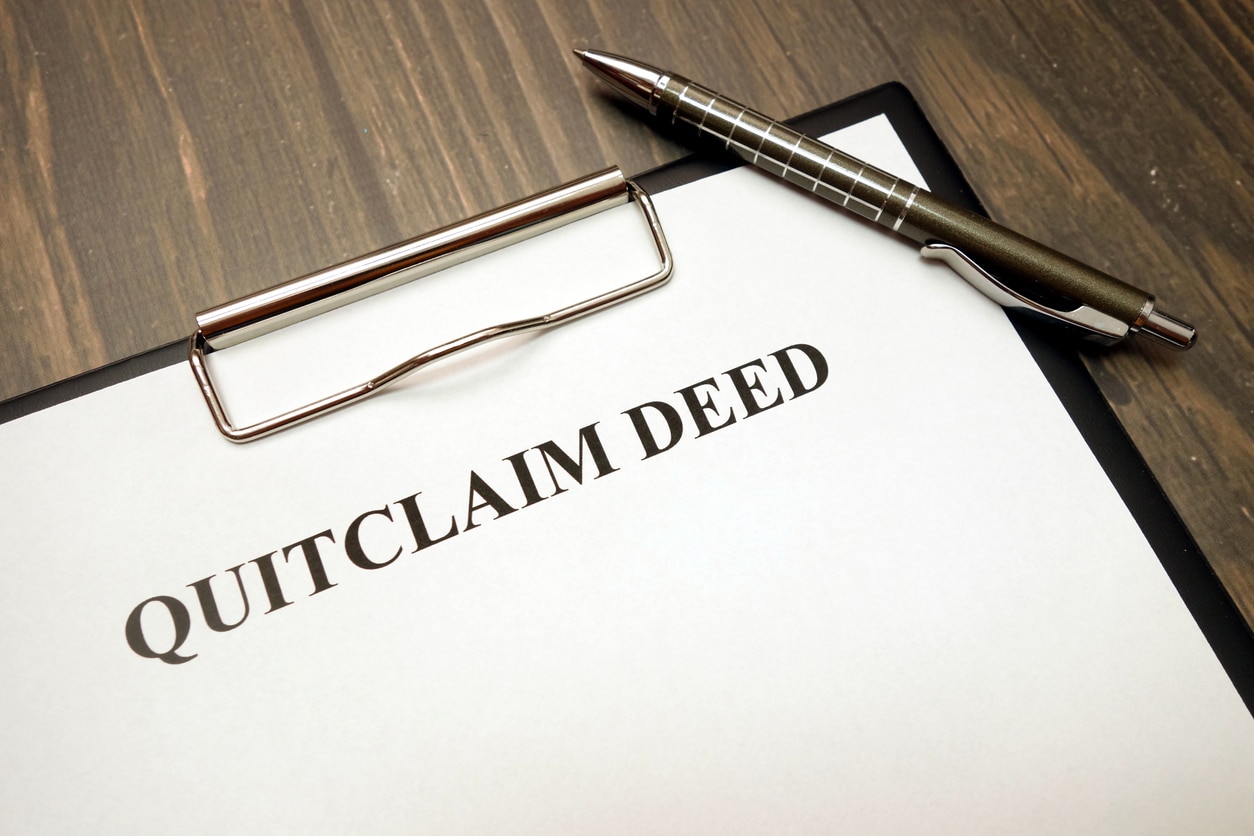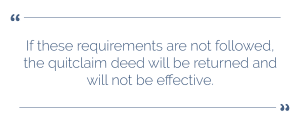

There may be a point in time where you may be wondering how to file a quitclaim deed. This article provides a comprehensive guide on how to file a quitclaim deed, particularly in Los Angeles County, California. It begins by explaining what a quitclaim deed is, highlighting that it only transfers the same interest that the grantor had at the time the deed was signed. The article then outlines the requirements for preparing and filing a quitclaim deed, such as the need for original signatures, a legible notary seal, and a completed Preliminary Change of Ownership Report. Finally, it explains the process of filing a quitclaim deed, which involves a notary and recording the original document at the Local County Recorder’s office.
Like all deeds related to real property, quitclaim deeds are documents used to convey some interest in property from one person to another. Quitclaim deeds typically include the words “assign,” “release,” “quitclaim,” or “transfer” or “right, title, and interest.” A key aspect distinguishing quitclaim deeds from other types of deeds is that it only transfers the same interest that the grantor of the quitclaim deed had at the time the deed was signed. Unlike a grant deed, which presumably transfers all rights in the property to the grantee, a quitclaim deed only transfers what rights and interests the grantor had at the time. Thus, a quitclaim deed is only as good as the interest the owner has. For example, if the owner has no interest, then a quitclaim deed conveys nothing. The beauty of a quitclaim deed is that the person providing it does not even need to know what interest they have to execute it – essentially they are saying I am giving you whatever I have even if I do not know what I have.

Quitclaim deeds are typically used in situations where the transfer of property is between family members, such as parents transferring property to their children, or between spouses, especially in the case of divorce. They are also used to clear up title issues, such as when a property’s ownership is in question and needs to be resolved. Additionally, quitclaim deeds can be used to add or remove a party from the title, such as adding a spouse after marriage. It’s important to note that quitclaim deeds do not provide any warranties or guarantees regarding the property’s title, making them less suitable for transactions between unrelated parties or those that require a clear title. The key to a quitclaim indeed is that the the grantor does not have to warrant the title they are conveying.
ALSO READ Can You Void a Deed After Gifting It?We frequently see quitclaim deeds executed by spouses or significant others who are not going on title to a property at the time of purchase. In those situations, lenders want to avoid title disputes or ownership disputes in the future so they have the spouse/significant other who is not going on title execute a quitclaim deed in favor of the party buying the property to try to make it clear that the spouse/significant other has no ownership interest from the outset of the transaction.
Other important requirements for preparing and filing a quitclaim deed in Los Angeles County include the following:
After preparing the necessary quitclaim deed document according to the above requirements, in California, the quitclaim deed also needs to be notarized pursuant to the California Government Code, which specifies that documents recorded in the County Recorder’s office, unless exempt by law, must be properly acknowledged. (California Government Code §§ 27201, 27289, 27285, 27287, 27288; C.C. § 1189.) After proper notarization, the quitclaim deed can be recorded at the Local County Recorder’s office, typically either in person or by mail when the appropriate fees are included. If you need help getting the document recorded you can go to a notary at a place that provides them or order a roaming notary online. Notaries have maximum fees they can charge per signature but they can charge travel time and other related charges.
ALSO READ Can Somebody Take Back Property Gifted To You Legally?Going back to the example in Los Angeles County, a quitclaim deed can be submitted in person to the Registrar-Recorder/County Clerk Document Analysis and Recording Section along with the relevant fees. If these requirements are not followed, the quitclaim deed will be returned and will not be effective. There are several offices in Los Angeles County you can go to for recording but the main one is in Norwalk, California. “Walking a document through” in person is the quickest way to get the document recorded.
Nullifying a quitclaim deed can be challenging because once a quitclaim deed has been signed and recorded, it typically cannot be revoked unilaterally by the grantor. To nullify a quitclaim deed, one might need to prove that the deed was signed under duress, fraud, or mistake. This often involves legal proceedings where the court must be convinced that the circumstances justify invalidating the deed. If both parties agree to reverse the transaction, they can execute a new quitclaim deed that transfers the property back to the original owner. Seeking legal advice is crucial in such situations to ensure the correct legal procedures are followed. If you are trying to reverse a prior quitclaim deed, the county assessor’s office may view that second transaction as a new one causing the property to be reassessed.
Sometimes, you need to undo a quitclaim deed but you cannot get cooperation from the person who is the grantee or received the deeded property. In those uncooperative situations, you may have to bring an action to “quiet title” – the process where you go to court to change record title for reasons like fraud, mistake or other legal issues.
The process of transferring property through a quitclaim deed involves several key steps:
By following these steps, the property transfer through a quitclaim deed becomes legally effective, ensuring the new owner’s interest in the property is recognized.
To schedule a consultation with one of our Los Angeles based real estate attorneys , you can call us directly at (310) 954-1877, or send us a message here .